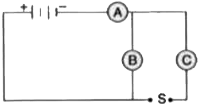Entoptic halos. If someone looks at a bright outdoor lamp in otherwise dark surroundings, the lamp appears to be surrounded by bright and dark rings (hence halos) that are actually a circular diffraction pattern, with the central maximum overlapping the direct light from the lamp. The diffraction is produced by structures within the cornea or lens of the eye (hence entoptic). If the lamp is monochromatic at wavelength 550 nm and the first dark ring subtends angular diameter 2.0∘ in the observer's view, what is the linear) diameter of the structure producing the diffraction?
38 μm
Topper's Solved these Questions
- INTERFERENCE AND DIFFRACTION BOOK - RESNICK AND HALLIDAYCHAPTER - INTERFERENCE AND DIFFRACTION EXERCISE - PRACTICE QUESTIONS (Single Correct Choice Type)
66 Videos
- INTERFERENCE AND DIFFRACTION BOOK - RESNICK AND HALLIDAYCHAPTER - INTERFERENCE AND DIFFRACTION EXERCISE - PRACTICE QUESTIONS (More than One Correct Choice Type)
23 Videos
- INTERFERENCE AND DIFFRACTION BOOK - RESNICK AND HALLIDAYCHAPTER - INTERFERENCE AND DIFFRACTION EXERCISE - CHECKPOINT
6 Videos
- HYDROGEN ATOMBOOK - RESNICK AND HALLIDAYCHAPTER - HYDROGEN ATOMEXERCISE - PRACTICE QUESTIONS(Integer Type)
6 Videos
- MAGNETIC FIELDS DUE TO CURRENTSBOOK - RESNICK AND HALLIDAYCHAPTER - MAGNETIC FIELDS DUE TO CURRENTSEXERCISE - Practice Question (Integer Type)
4 Videos
Similar Questions
Knowledge Check
Diffraction pattern of a single slit consists of a central bright band which is
Awide, and is flanked by alternate dark and bright bands of decreasing intensityBnarrow, and is flanked by alternate dark and dright bands of equal intensityCwide, and is flanked by alternate dark and bright bands of equal intensityDnarrow, and is flanked by alternate-dark and bright bands of decreasing intensityFind the half angular width of the central bright maximum in the fraunhofer diffraction pattern of a slit of width 12×10−5cm when the slit is illuminated by monochromatic light of wavelength 6000 Å.
A40∘B45∘C30∘D60∘A, B in the figure are identical lamps. What changes occur in the brightness of the lamps when its switch S in closed?
 ABrightness of A increases but that of B decreasesBBrightness of A remains the same but that of B decreasesCBrighness of both A and B decreasesDBrightness of A increases but that of B remains the same
ABrightness of A increases but that of B decreasesBBrightness of A remains the same but that of B decreasesCBrighness of both A and B decreasesDBrightness of A increases but that of B remains the same
Find the half angular width of the central bright maximum in the fraunhofer diffraction pattern of a slit of width 12×10−5cm when the slit is illuminated by monochromatic light of wavelength 6000 Å.
View SolutionFind the half angular width of the central bright maximum in the fraunhofer diffraction pattern of a slit of width 12×10−5cm when the slit is illuminated by monochromatic light of wavelength 6000 Å.
View SolutionWhat is the photon energy for yellow light from a highway sodium lamp at a wavelength of 589 nm?
View SolutionCalculate the frequency (v) and wave number (¯v) of the yellow light with a wavelength of 580 nm emitted from sodium lamp.
View SolutionA converging lens is to projected image of a lamp 4 times the size of the lamp on a wall at a distance of 10m from the lamp. The focal length of the lens is
View Solution
